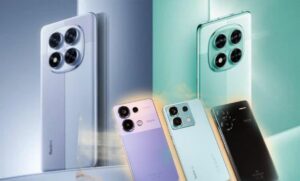
For just a little more money, you can get the Redmi Note 13 4G. This was a comment left on my Redmi 13 review, and I completely agree. You should definitely choose the Note 13 over the Redmi 13. Trust me, it’s the better phone.
First off, the Note 13 has superior build quality. It features Gorilla Glass 3 protection for the screen, while the Redmi 13 also has Gorilla Glass 3 protection. The Note 13 comes with an IP54 rating for water and dust resistance, whereas the Redmi 13 has an IP53 rating. Additionally, the Note 13 has stereo speakers, while the Redmi 13 only has one speaker. The Note 13 also boasts a more advanced under-display fingerprint reader, while the Redmi 13 has a regular side-mounted fingerprint reader.
However, it’s worth noting that the Redmi 13 has a glass rear, while the Note 13 has a plastic back. This might seem like an advantage for the Redmi 13, but glass is more fragile than plastic, so is it really an advantage?
Now, let’s talk about the displays. Both phones have the same resolution, but the Note 13 has a better display type, a higher refresh rate, smaller bezels, and a brighter screen. So, on paper, it definitely has the better specs, and in real life, you can see the difference too. Whether you’re watching movies, gaming, or scrolling, the Note 13’s display is noticeably superior.
When it comes to performance, the Note 13 outshines the Redmi 13. The Note 13 uses the Snapdragon 685 processor, while the Redmi 13 uses the Helio G91. I ran benchmarks on both, and the Note 13 came out on top, although the gap wasn’t as wide as I expected. My experience with the Redmi 13 was disappointing; it felt slow and stuttered a lot. In contrast, the Note 13 performed smoothly. This could be due to the faster storage type used in the Note 13. So, even though the difference on paper isn’t huge, in actual use, the Note 13 is noticeably faster.
Of course, these are still budget phones, so you can’t expect top-tier performance. They may still stutter occasionally and handle games at medium graphics settings. They won’t be the best for multitasking or opening apps instantly. But if you have to choose between these two, the Note 13 is the clear winner.
For cameras, both phones have a 108MP main camera and a 2MP macro lens. However, the Note 13 has an additional 8MP ultrawide camera. For selfies, the Note 13 features a 16MP camera, while the Redmi 13 has a 13MP camera. Starting with the main camera, their performance is comparable. Some pictures I preferred from the Note 13, while others I liked from the Redmi 13. Overall, I would give the edge to the Note 13 because of its ultrawide camera, which, although only 8MP, is useful for certain shots.
When it comes to the selfie camera, the Note 13 has the better specs, but I actually preferred the Redmi 13. It performed better with color accuracy and consistency.
Next, I compared video quality. Both phones shoot at 1080p 30fps, but I wasn’t impressed with the video quality from either. The Note 13 looked a bit soft, while the Redmi 13 appeared over-sharpened. If I had to choose, I would lean towards the Note 13 because it seems to have a bit of stabilization.
For battery life, the Redmi 13 has a slightly larger battery at 5030mAh. However, due to the more efficient processor in the Note 13 and its AMOLED display, it actually ends up having better battery life. I watched a YouTube video for an hour and a half on both phones. The Redmi 13 lost 9% of its battery, while the Note 13 lost only 8%. So, the Note 13 has slightly better battery performance. Both phones should easily last a day with medium use.
In terms of charging, both phones support up to 33W of wired charging, so you can expect to fully charge them in just over an hour. There’s no real difference here.
Regarding software, both devices run on HyperOS on top of Android 14. I plan to make a long-term review of the Note 13, where I’ll discuss HyperOS and its new features in more detail.
So, what’s the verdict? As I mentioned earlier, everyone should choose the Note 13 over the Redmi 13, and I believe I’ve shown you why. The only reason to consider the Redmi 13 is if you don’t care much about performance and just need a phone for calls and a few pictures, and most importantly, if you’re looking to save money. However, I strongly encourage you to spend a little more and get the Note 13.
I’ve provided reviews for both phones, so if you want more information, feel free to check those out. I hope this comparison has helped you decide which phone to choose. Thank you for reading, and I’ll see you next time!



